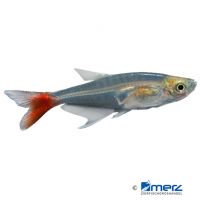Glass Bloodfin (Prionobrama filigera)
| Glass Bloodfin Prionobrama filigera | |
|---|---|
| Name | Glass Bloodfin |
| Name Lat. | Prionobrama filigera |
| Family | Characins |
| Family lat. | Characidae |
| Order | Characins |
| Order lat. | Characiformes |
| Origin | South America |
| Habitat | Streams, tributaries |
| Diet | Carnivore |
| pH | 6.0-7.5 |
| Behavior | Peaceful |
| Keeping | Group |
| Care Level | Easy |
| Reproduction | Egg scatterer |
| Breeding | Moderately difficult |
| Life Span | 6-10 years |
| Protection | No |
| Metric Units | |
| Size | 6 cm |
| Temperature | 22-28 °C |
| Hardness | 5-15 °dH |
| Aquarium | 70 l |
| US Units | |
| Size | 2.4" |
| Temperature | 72-82 °F |
| Hardness | 89-267 ppm |
| Aquarium | 20 gal |
Distribution and habitat
The redfin tetras are common in the Amazon tributaries of Colombia, Ecuador, Peru and Brazil. There they live in the slow-flowing streams and small rivers, where they usually stay in loose schools under overhanging riparian vegetation.
Maintenance
The aquarium should have a varied, partly dense planting, with shelters and hiding places (roots) and provide sufficient swimming space. A dark substrate covered with some foliage (e.g. sea almond leaves), shaded light (floating plants) and soft, slightly acidic water as well as a weak current is ideal.
No ammonia, ammonium and nitrite should be detectable, the nitrate value should not exceed 100 mg/l. To ensure the water quality and oxygen content, a filter and heater adapted to the aquarium size is required, as well as lighting for the species-appropriate day-night rhythm of the animals.
Diet
In nature they feed mainly on insects picked up from the water surface (approach food). The food supply consists of live or frozen cyclops, daphnia, artemia, mosquito larvae, etc. or a commercially available frozen food mix. High-quality, protein-rich dry food, such as micropellets or flake food is also well accepted.
Only feed as much as is eaten immediately (in a maximum of 10 minutes). Regular and varied feeding promotes health and increases resistance
Behaviour and compatibility
These peaceful and sociable fish should be kept in a group of at least 6-8, but preferably more. They are very suitable for a South America community tank and can be socialized well with other peaceful fish of similar size, such as tetras, dwarf cichlids or armored catfish
Basically, only mutually compatible fish species with similar demands on water conditions and water temperature should be socialized.
Sex dimorphism
Males have a dark stripe on the longer extended anal fin
Reproduction and breeding
They are free spawners and do not engage in brood care. The female spawns, randomly between plants, 300 to 500 eggs. After 14-36 hours the young hatch and swim freely after another 3-4 days
The fry must be fed several times a day with special rearing food (infusoria, Artemia nauplii, dust food). In a community tank breeding is hardly possible, because the spawn is easy prey.
Important
They are good jumpers, so the aquarium should be well covered.
The foliage (sea almond tree, oak, etc.) enriches the water with humic substances, naturally lowers the pH and when rotting promotes the development of microorganisms, which are a valuable secondary food source.
The well-being of the fish should be monitored regularly. Temperature should be checked daily, pH, hardness and nitrate levels at least every 14 days. Regular partial water changes are recommended, even when contaminant levels have not yet reached the upper limit. Sudden changes in water quality should be avoided. Newly introduced fish must be accustomed slowly to the water in the aquarium.
Further literature can be found in your pet store.
References
Text: Werner Winter; Image: Merz Zierfischgroßhandel
Source: BMELV (1998): Tierschutzgutachten - Haltung von Zierfischen (Süßwasser); RIEHL & BAENSCH (2006): Aquarien Atlas Bd. 1, Mergus Verlag; ENGELMANN (2005): Zootierhaltung - Tiere in menschlicher Obhut: Fische, Verlag Harri Deutsch
- Gemäß § 21 Abs. 5 Tierschutzgesetz idgF
